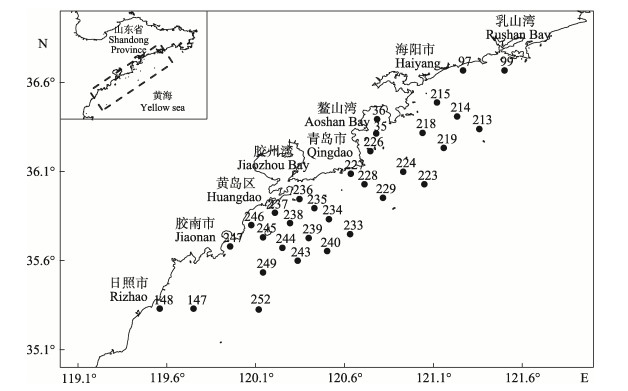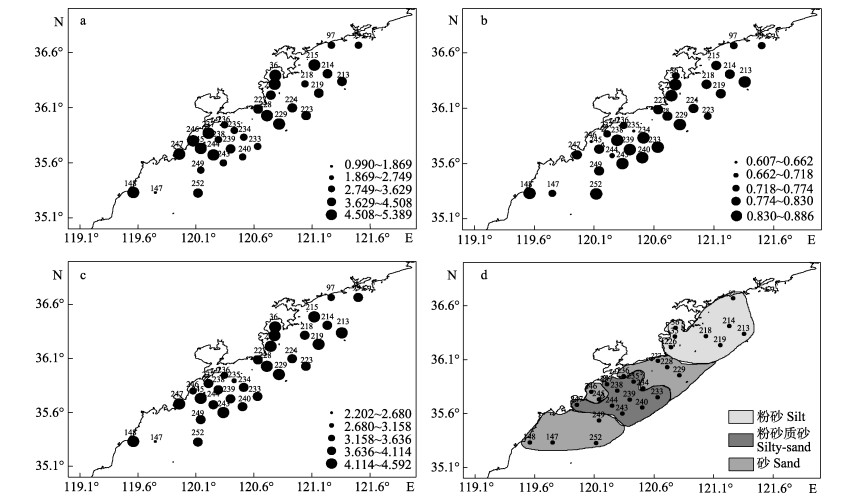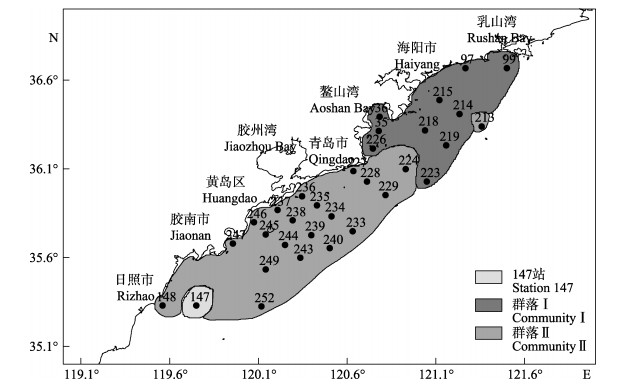2. 中国科学院海洋研究所 青岛 266071;
3. 国家海洋局第一海洋研究所 青岛 266061
2. Institute of Oceanology, Chinese Academy of Siences, Qingdao 266071;
3. The First Institute of Oceanography, State Oceanic Administration, Qingdao 266061
大型底栖动物是海洋生态系统的重要组成成分,它们通过摄食、掘穴和建管等扰动活动直接或间接地影响着海洋生态系统(田胜艳等, 2009)。大型底栖动物迁移能力弱、区域性强,对于环境污染及变化通常少有回避能力,可以较好地反映环境质量状况,在海洋生物监测中具有重要意义(罗先香等, 2009; Callier et al, 2008; Coyle et al, 2007)。
山东半岛南部濒临南黄海,海岸线曲折蜿蜒,沿岸多港口、海湾。近年来,有关山东半岛南部海域大型底栖动物已有报道,研究内容涉及种类组成、丰度生物量分布、物种多样性、群落结构和次级生产力等,但这些研究仅限于几个重要的海湾(季相星, 2012; 于海燕等, 2006; 赵宁等, 2013)及邻近海区(齐磊磊等, 2013; 王全超等, 2013; 王宗兴等, 2010)。目前,尚没有对整个山东南部沿岸海域大型底栖动物的研究报道。本文对2006年8月在山东半岛南部沿海采集的大型底栖动物样品进行了种类组成、丰度生物量分布、群落结构和多样性等进行研究,以期为该海域生态系统的深入研究提供参考。
1 材料与方法 1.1 站位设置在山东南部沿岸海域设置了12个断面,共32个站位。研究海域北起乳山湾南侧海域,南至日照港,站位见图 1。

|
图 1 研究海域站位 Figure 1 The map of sampling stations in the investigated waters |
2006年8月14~22日,乘坐鲁即渔水0669船进行大型底栖动物样品的采集。使用0.05 m2抓斗式采泥器采泥,每站3~4次,采用0.5 mm孔径的网筛分选沉积物样品,分选后所得样品用10%的福尔马林溶液保存固定。样品的处理、保存、计数和称量等均按照中华人民共和国质量监督检验检疫总局(2007)《海洋调查规范》方法进行。
1.3 环境因子测定每站取适量沉积物样品,分别用于沉积物粒度和有机碳的测定。沉积物粒度采用Cilas 940L型激光粒度仪。依据矩值法计算粒度参数(McManus, 1988),通过Folk法分析沉积物类型(王中波等, 2007)。有机碳测定则按照中华人民共和国质量监督检验检疫总局(2007)《海洋调查规范》中重铬酸钾-硫酸氧化法及刘昌岭等(2007)的改进方法进行。
1.4 数据处理 1.4.1 优势种确定采用相对重要性指数IRI(Index of Relative Importance)进行优势种的确定。计算公式如下:
| $ {\rm{IRI}} = (W + N) \times F $ |
式中,W为每种的生物量占总生物量的百分比,N为每种的丰度占总丰度的百分比,F为该种出现的频率。
1.4.2 多样性指数计算本研究采用了Margalef丰富度指数(d)、Shannon-Wiener多样性指数(H’)以及Pielou’s均匀度指数(J)进行多样性分析,公式如下:
| $ \begin{array}{*{20}{c}} {H\prime = - \sum \left({{n_i}/N} \right) \times {\rm{lo}}{{\rm{g}}_2}\left({{n_i}/N} \right)}\\ {J = H\prime /{\rm{lo}}{{\rm{g}}_2}S}\\ {d = \left({S - 1} \right)/{\rm{lo}}{{\rm{g}}_2}N} \end{array} $ |
式中,S为样品的总种数,N为样品的总个体数,ni为第i种的个体数。
1.4.3 群落结构分析利用PRIMER 5.0软件对大型底栖动物进行CLUSTER分析和MDS分析。应用ANOSIM检验各群落之间是否有显著差异,SIMPER分析并了解表征群落的特征种及造成群落差异的物种。通过PCA分析环境因子主成分,再使用BIOENV分析出与群落相关性最密切的环境因子组合,并对其进行RELATE检验。使用SPSS 17.0软件进行Pearson相关性分析。
2 结果与分析 2.1 大型底栖动物种类组成本研究共采集到大型底栖动物182种。其中,多毛类92种,占总物种数的51%;甲壳类42种,占总物种数的23%;软体动物29种,占总物种数的16%;棘皮动物9种,占总物种数的5%;其他类群10种,分别是腔肠动物(5种)、扁形动物(1种)、纽形动物(1种)、腕足动物(1种)、头索动物(1种)和鱼类(1种),占总物种数的5%。
表 1为IRI指数前10位的种。其中,8种多毛类,1种软体动物,1种甲壳类,说明了多毛类在研究海域底栖动物群落中的重要性。
|
|
表 1 相对重要性指数排名前10位的种 Table 1 The top 10 IRI species |
研究海域大型底栖动物的总平均丰度为2001 ind./m2,多毛类占绝对优势,平均丰度为1332 ind./m2,占总平均丰度的66%;甲壳类平均丰度为358 ind./m2,占总平均丰度的18%;软体动物平均丰度为264 ind./m2,占总平均丰度13%;棘皮动物平均丰度为33 ind./m2,占总平均丰度的2%;其他类群平均丰度为14 ind./m2,占总平均丰度的1%。
研究海域大型底栖动物的总平均生物量为15.92 g/m2,软体动物和多毛类比重最大,分别为5.28和4.91 g/m2,占总平均生物量的33%和31%;甲壳动物平均生物量为1.41 g/m2,占总平均生物量的9%;棘皮动物平均生物量为0.80 g/m2,占总平均生物量的5%;其他类群平均生物量为3.52 g/m2,占总平均生物量的20%。
从丰度的空间分布来看(图 2a),最高值出现在乳山湾南侧外部海域的99站位,其丰度达到4040 ind./m2,出现了大量的稚齿虫、锥头似帚毛虫(Lygdamis giardi)、西方似蛰虫(Amaeana occidentalis)、秀丽波纹蛤(Raetellops pulchella)、边鳃拟刺虫(Linopherus paucibranchiata)和脆壳理蛤(Theora fragilis)等,以上物种构成该站总丰度的75%,其中,稚齿虫占绝对优势,其丰度高达980 ind./m2;次高值出现在靠近胶州湾湾口的235号站,其丰度为3400 ind./m2,微型小海螂以1600 ind./m2的丰度占绝对优势。最低值出现在靠近胶南南部外部海域的252站位,其丰度仅为647 ind./m2;次低值出现在日照近岸海域148站位,其丰度为790 ind./m2。丰度高值区主要集中在鳌山湾、北部沿岸海域以及胶南附近海域。低值区主要集中在研究海域南部的外部海域及日照沿岸海域。

|
图 2 大型底栖动物丰度(ind./m2)(a)及生物量(g/m2)(b)分布 Figure 2 The distribution of abundance (ind./m2) (a) and biomass (g/m2) (b) of macrobenthos |
从大型底栖动物生物量的空间分布看(图 2b),最高值出现在海阳海域外部的213号站,其生物量达到50.93 g/m2,其主要原因是采集到了生物量较大的间褶拟蚶(Arcopsis interplicata),其生物量高达39.50 g/m2;次高值出现在胶南沿岸的245站,生物量为50.67 g/m2,其主要的贡献种为经氏壳蛞蝓(Philine kinglippini)和异足索沙蚕(Lumbrinereis heteropoda);最低值出现在青岛沿岸外部海域的233号站,生物量仅为0.14 g/m2;次低值出现在日照沿岸海域的147号站,其生物量为2.46 g/m2。各海区均有生物量较高的站位,生物量分布无明显的规律。
2.3 大型底栖动物多样性指数分析从表 2可以看出,大型底栖动物d最高值出现在青岛沿岸外部海域的229号站(5.39),最低值在日照近岸海域的147号站(0.99);J最高值出现在黄岛沿岸外部海域的243号站(0.89),最低值出现在胶南近岸海域的247号站(0.61);H’分布范围为2.20~4.59,平均值为3.92,分布在4.00~5.00之间的有17个站,分布在3.00~4.00之间的有14个站;最高值位于229号站(4.59),最低值分布在147号站(2.20)。
|
|
表 2 大型底栖动物丰度、生物量、多样性指数和沉积物类型 Table 2 The abundance, biomass, diversity indexes and sediment types of macrobenthos in the investigated waters |
研究海域多样性指数及沉积物类型的空间分布见图 3。从图 3可以看出,d的高值区主要位于青岛–鳌山湾–海阳沿岸海域以及胶南附近海域,低值区主要位于南部黄岛–胶南沿岸的外部海域。除鳌山湾内站位(35、36号站)及个别站位(223、226、236、244和148号站)外,J总体呈现出由近岸海域向远岸海域逐渐增加的趋势。整个研究海域的H’总体较高,北部海域大于南部海域。研究海域北部沉积物类型多为粉砂,南部多为粉砂质砂,除个别站位(227、228、229、234和236号站)外,由北至南呈现沉积物粒径增大的趋势,这与张晓波(2014)对山东半岛南部近岸海域沉积物研究的结果一致。

|
图 3 大型底栖动物多样性指数及沉积物类型分布 Figure 3 The spatial distribution of diversity index of macrobenthos and sedimental types a:丰富度指数;b:均匀度指数;c:多样性指数;d:沉积物类型 a: d ; b: J; c; H': d: Sedimental types |
H’指数通常被认为是一种评价水域有机质污染的有效工具,对其进行分级以评价海域的污染情况。按照蔡立哲等(2002)对H’的污染评价方法进行分类,本研究中仅有位于日照近岸海域的147号站为轻度污染,其他站位均为清洁。20世纪90年代以来,日照市对其沿海地区加大了开发利用,如扩建码头、围海造地、建造发电厂及其垃圾掩埋地等,使得日照近海环境发生了巨大的改变(齐磊磊等, 2013)。从总体上看,海域的底栖生态环境为清洁。
2.4 大型底栖动物群落结构依据大型底栖动物的丰度,对研究海域站位进行聚类分析结果见图 4。从图 4可以看出,在36%的相似度水平上,可将大型底栖动物分为2个群落(147站作为单独站位不适宜划分为一个群落)。ANOSIM分析显示,2个群落之间差异极显著(r=0.39, P < 0.01)。各群落空间分布及基本参数见图 5和表 3。

|
图 4 大型底栖动物丰度聚类结果 Figure 4 Results of cluster analysis on macrobenthic abundance in the investigated waters |

|
图 5 大型底栖动物群落分布 Figure 5 The distribution of macrobentic communities in the investigated waters |
|
|
表 3 大型底栖动物各群落基本参数 Table 3 The environmental and biotic parameters of each macrobenthic community |
群落Ⅰ:由35、36、97、99、214、215、218、219、223和226站共10个站位组成。群落Ⅰ分布于鳌山湾–海阳–乳山湾沿岸海域,沉积物类型均为粉砂质,平均水深最浅,但平均有机碳含量(0.44%)和平均H’(4.02)均为最高。群落Ⅰ共出现100种大型底栖动物,其平均丰度为2620 ind./m2,平均生物量为18.26 g/m2。SIMPER分析表明,群落Ⅰ各站位平均相似性为38.28%,特征种为中蚓虫、寡鳃齿吻沙蚕、稚齿虫、脆壳理蛤和不倒翁虫等。
群落Ⅱ:包括余下除147站外的21个站位。群落Ⅱ主要分布于日照–胶南–黄岛–青岛沿岸海域,沉积环境多为粉砂质砂,其中,213号站在地理分布上比较特殊,分布在海阳沿岸外部海域,被群落Ⅱ站位包围,其分布原因有待进一步研究。该群落共出现150种大型底栖动物,平均丰度、平均生物量和平均多样性指数分别为1746 ind./m2、15.45 g/m2和3.95,平均有机碳含量为0.36%。SIMPER分析表明,群落Ⅱ站位间的平均相似性为28.32%,寡鳃齿吻沙蚕、独指虫、巴氏钩毛虫、拟特须虫和中蚓虫为该群落的特征种。
位于日照沿岸的147号站,只采集到4种多毛类和4种软体动物。大型底栖动物的丰度为1140 ind./m2,生物量为2.46 g/m2。紫壳阿文蛤(Alvenius ojianus)丰度达到540 ind./m2,占绝对优势;其次是日本长尾虫(Apseades nipponicus)和拟特须虫,丰度分别为220和200 ind./m2。该站的沉积物类型为砂质,沉积物中砾石含量为15.87%,有机质含量最低,只有0.11%,可推测出该站的环境较为贫瘠,不适宜生物生存。
SIMPER分析表明,Ⅰ、Ⅱ两个群落的非相似性为77.21%,造成群落差异的主要物种为中蚓虫、寡鳃齿吻沙蚕、稚齿虫、脆壳理蛤、巴氏钩毛虫、不倒翁虫、微型小海螂、秀丽波纹蛤、独指虫、轮双眼钩虾(Ampelisca cyclops)和拟特须虫,这些种的累积贡献率为50.72%。
2.5 丰度生物量与环境因子相关性分析利用SPSS软件对大型底栖动物各站位的丰度、生物量与各环境因子进行Pearson相关性分析。结果显示, 丰度与水深呈显著负相关(r=-0.38, P < 0.05) (表 4)。对照研究海域的等深线图(图 6)和大型底栖动物丰度分布图(图 3a),在胶南附近和鳌山湾以北部分的丰度高值区水体深度浅,而在南部外部海域的丰度低值区水深达到最深,即深度越深,底栖动物的丰度越小。周然等(2014)的研究也指出,水深是影响底栖生物分布的重要因子。Mutlu等(2010)研究则指出,水深通常是影响多毛类分布的主要环境因子。对水深和优势种进行Pearson相关性分析,显示独指虫和稚齿虫的丰度与水深呈显著相关(r=0.366, r=-0.368)。
|
|
表 4 大型底栖动物丰度、生物量与环境因子相关系数 Table 4 Pearson correlation between the marcobenthic abundance, biomass and environmental factors |

|
图 6 研究海域等深线 Figure 6 The depth contour map of the investigated waters |
主成分分析计算结果见表 5。从表 5可以看出,第1主成分的贡献率为66.30%,负载主要集中在中值粒径、粉砂、黏土和砾石上,说明第1主成分代表的是沉积物粒径的不同。第2主成分贡献率为14.80%,主要相关的环境因子是水深。2个主成分的累积贡献率为81.10%,即前2个主成分能相当好地反映出各站位真实的环境差异(Clarke et al, 2001)。基于环境的差异将所有站位划分成3组,结果见图 7a,对比MDS的结果见图 7b。从图 7可以看出,PCA和MDS不是很匹配,说明所测的环境因子不能对观察到的群落结构给予很好的解释(周红等, 2003)。PCA和MDS的不匹配可能是因为缺乏关键环境因子(Clarke et al, 2001),例如水温等,水温是影响大型底栖动物群落结构的主要环境因子(周然等, 2014)。
|
|
表 5 环境因子PCA结果 Table 5 The results of principal component analysis of environmental factors |

|
图 7 PCA排序图(a)及MDS排序图(b) Figure 7 PCA ordination (a) and MDS ordination (b) |
用BIOENV分析丰度矩阵与环境因子矩阵的相关性,得出与群落结构相关性最密切的环境因子组合为粉砂+水深+有机碳(0.46),该组合是对观察到的群落结构最好的解释。Relate检验得出丰度相似性矩阵和最佳环境因子相似性矩阵之间呈极显著相关(r=0.39, P < 0.01)。
3 讨论将本研究结果与其他相近的研究结果对比见表 6。从表 6可以看出,在优势种方面,本研究及山东沿岸各海域的研究均是多毛类占优势,再次说明了多毛类在山东沿岸大型底栖动物群落中的重要性。与本研究优势种(表 1)相比较,不倒翁虫也是乳山湾及邻近海域、日照近海、烟台近海及南黄海研究中的优势种,寡鳃齿吻沙蚕作为优势种,同样出现在乳山湾及邻近海域、日照近海和青岛近海,巴氏钩毛虫、拟特须虫同样是日照近海、青岛近海的优势种。这4种多毛类多为个体小,生活周期较短的广温种(刘瑞玉等, 1986; 杨德渐等, 1988)。
|
|
表 6 本研究结果与有关研究的对比 Table 6 Comparison between this study and other related studies |
本研究中的大型底栖动物丰度在所有的研究海域中为最高,原因可能是沉积物底质的不同。沉积物是影响大型底栖分布的重要因素(刘瑞玉等, 1986; Commito et al, 2006)。另一个原因可能是水温、水深和盐度等水文条件的不同。陆强等(2013)研究显示,水温是影响春、夏季大型底栖动物分布的主要环境因子。张敬怀(2014)研究发现,夏季大型底栖动物丰度与盐度呈显著正相关,浅水区相对于深海具有更高丰度、生物量和次级生产力。此外,网筛孔径、取样站位数和采泥器类型等人为因素的不同也是可能的原因。李新正等(2005)的研究指出,使用0.5 mm网筛所得到底栖样品的丰度是1.0 mm网筛的1.36倍。
在生物量上,乳山湾及邻近海域研究中的生物量最高,为229.22 g/m2,原因是在靠近养殖区的站位采到了生物量占绝对优势的菲律宾蛤仔(Ruditapes philippinarum)。本研究中的生物量在所有研究海域中最低,为15.92 g/m2,其原因可能与山东近岸海域陆源排污、人为捕捞以及过度开发利用等引起的生态环境变化有关。
| Cai LZ, Ma L, Gao Y, et al. Analysis on assessing criterion for polluted situation using species diversity index of marine macrofauna. Journal of Xiamen University (Natural Science), 2002, 41(5): 641-646 [蔡立哲, 马丽, 高阳, 等. 海洋底栖动物多样性指数污染程度评价标准的分析. 厦门大学学报(自然科学版), 2002, 41(5): 641-646] | |
| Callier MD, Mckindsey CW, Desrosiers C. Evaluation of indicators used to detect mussel farm influence on the benthos: Two case studies in the Magdalen Islands, Eastern Canada. Aquaculture, 2008, 278(1-4): 77-88 DOI:10.1016/j.aquaculture.2008.03.026 | |
| Clarke KR, Warick RM. Change in marine communities: An approach to statistical analysis and interpretation (2nd edition). PRIMER-E: Plymouth, 2001: 25-50. | |
| Commito JA, Dow WE, Grupe BM. Hierarchical spatial structure in soft-bottom mussel beds. Journal of Experimental Marine Biology and Ecology, 2006, 330(1): 27-37 DOI:10.1016/j.jembe.2005.12.015 | |
| Coyle KO, Konar B, Blanchard A, et al. Potential effects of temperature on the benthic infaunal community on the southeastern Bering Sea shelf: Possible impacts of climate change. Deep Sea Research Part Ⅱ: Topical Studies in Oceanography, 2007, 54(23-26): 2885-2905 DOI:10.1016/j.dsr2.2007.08.025 | |
| General Administration of Quality Supervision, Inspection and Quarantine of the People's Republic of China, Standardization Administration of the People's Republic of China. Specifications for Oceanographic Survey, Part 6: Marine Biological Survey (GB/T12763.6-2007). Beijing: China Standards Press, 2007. [中华人民共和国国家质量监督检验检疫总局, 中国国家标准化管理委员会. 海洋调查规范-海洋生物调查(GB/T 12763.6-2007). 北京: 中国标准出版社, 2007.] | |
| Ji XX. The ecological study of macrofanua in Qingdao Bay Intertidal zone. Master's Thesis of Ocean University of China, 2012, 1-71 [季相星. 青岛湾潮间带大型底栖动物生态学研究. 中国海洋大学硕士研究生学位论文, 2012, 1-71] http://cdmd.cnki.com.cn/Article/CDMD-10423-1015717219.htm | |
| Li XZ, Wang HF, Wang JB, et al. Comparison of sampling results of macrobenthos using different apertures of sampling sieve in Jiaozhou Bay. Marine Sciences, 2005, 29(12): 68-74 DOI:10.3969/j.issn.1000-3096.2005.12.015 [李新正, 王洪法, 王金宝, 等. 不同孔径底层筛对胶州湾大型底栖动物取样结果的影响. 海洋科学, 2005, 29(12): 68-74] | |
| Liu CL, Zhu ZG, He XL, et al. Rapid determination of organic carbon in marine sediment samples by potassium dichromate oxidation-ferrous sulphate titrimetry. Rock and Mineral Analysis, 2007, 26(3): 205-208 [刘昌岭, 朱志刚, 贺行良, 等. 重铬酸钾氧化-硫酸亚铁滴定法快速测定海洋沉积物中有机碳. 岩矿测试, 2007, 26(3): 205-208] | |
| Liu RY, Cui YH, Xu FS, et al. Ecological characteristics of macrobenthos of the Yellow Sea and the East China Sea. Studia Marina Sincia, 1986(27): 154-173 [刘瑞玉, 崔玉珩, 徐凤山. 黄海、东海底栖生物的生态特点. 海洋科学集刊, 1986(27): 154-173] | |
| Lu Q, Chen HL, Shao XY, et al. Ecological characteristics of macrobenthic communities and its relationships with enviromental factors in Hangzhou Xixi Wetland. Acta Ecologica Sinica, 2013, 33(9): 2803-2815 [陆强, 陈慧丽, 邵晓阳, 等. 杭州西溪湿地大型底栖动物群落特征及与环境因子的关系. 生态学报, 2013, 33(9): 2803-2815] | |
| Luo XX, Yang JQ. Progress in researches on benthic indices of assessing marine ecosystem health. Marine Science Bulletin, 2009, 28(3): 106-112 [罗先香, 杨建强. 海洋生态系统健康评价的底栖生物指数法研究进展. 海洋通报, 2009, 28(3): 106-112] | |
| McManus J. Grain size determination and interpretation. Technique in Sedimentology, 1988, 63 | |
| Mutlu E, Cinar ME, Ergev MB. Distribution of soft-bottom polychaetes of the Levantine coast of Turkey, eastern Mediterranean Sea. Joumal of Marine Systems, 2010, 79(1): 23-25 | |
| Qi LL, Wang QX, Guan SG, et al. Community structure of macrobenthos in coastal waters of Rizhao. Marine Fisheries Research, 2013, 34(1): 97-102 [齐磊磊, 王其翔, 官曙光, 等. 日照近海大型底栖动物群落结构. 渔业科学进展, 2013, 34(1): 97-102] | |
| Seo JY, Lim HS, Choi JW. Distribution patterns of macrobenthic fauna communities in Deukryang Bay, one of the environment conservation areas of Korea. Ocean Science Journal, 2014, 49(2): 97-113 DOI:10.1007/s12601-014-0011-z | |
| Seo JY, Park SH, Lee JH, et al. Structural changes in macrozoobenthic communities due to summer hypoxia in Gamak Bay, Korea. Ocean Science Journal, 2012, 47(1): 27-40 DOI:10.1007/s12601-012-0003-9 | |
| Tian SY, Zhang WL, Zhang R. Role of macrobenthos in marine ecosystem. Journal of Salt and Chemical Industry, 2009, 38(2): 50-54 [田胜艳, 张文亮, 张锐. 大型底栖动物在海洋生态系统中的作用. 盐业与化工, 2009, 38(2): 50-54] | |
| Wang QC, Li BQ. Community structure of macrobenthos in coastal water off Yantai, east China. Oceanologia et Limnologia Sinica, 2013, 44(6): 1667-1680 DOI:10.11693/hyhz20130300003 [王全超, 李宝泉. 烟台近海大型底栖动物群落特征. 海洋与湖沼, 2013, 44(6): 1667-1680] | |
| Wang XC. Ecological of macrobenthic community in Rushan bay and its adjacent waters. Master's Thesis of Ocean Unicersity of China, 2009, 29-30 [王晓晨. 乳山湾及邻近海域大型底栖动物群落的生态学研究. 中国海洋大学硕士研究生学位论文, 2009, 29-30] http://cdmd.cnki.com.cn/Article/CDMD-10423-2009171553.htm | |
| Wang ZB, Yang SY, Zhang ZX. Comparison of two classifications of clastic sediments. Marine Geology Letters, 2007, 23(3): 36-40 [王中波, 杨守业, 张志珣. 两种碎屑沉积物分类方法的比较. 海洋地质动态, 2007, 23(3): 36-40] | |
| Wang ZX, Fan SL, Xu QZ, et al. Characters of macrobenthic community in autumn in the coastal water of Qingdao. Transactions of Oceannology and Limnology, 2010, 30(1): 59-64 [王宗兴, 范士亮, 徐勤增, 等. 青岛近海秋季大型底栖动物群落特征. 海洋湖沼通报, 2010, 30(1): 59-64] | |
| Xu QZ, Li RX, Wang ZL, et al. Macrobenthos distribution of the south Yellow Sea in summer. Advances in Marine Science, 2009, 27(3): 393-399 [徐勤增, 李瑞香, 王宗灵, 等. 南黄海夏季大型底栖动物分布现状. 海洋科学进展, 2009, 27(3): 393-399] | |
| Yang DJ, Sun RP. China offshore polychaetes. Beijing: China Agriculture Press, 1988. [杨德渐, 孙瑞平. 中国近海多毛类. 北京: 农业出版社, 1988.] | |
| Yu HY, Li XZ, Li BQ, et al. The species diversity of macrobenthic fauna in Jiaozhou Bay. Acta Ecologica Sinica, 2006, 26(2): 416-422 [于海燕, 李新正, 李宝泉, 等. 胶州湾大型底栖动物生物多样性现状. 生态学报, 2006, 26(2): 416-422] | |
| Zhang JH. The variation of biodiversity of macrobenthic fauna with salinity and water depth near the Pearl Estuary of the northern South China Sea. Biodiversity Science, 2014, 22(3): 302-310 [张敬怀. 珠江口及邻近海域大型底栖动物多样性随盐度、水深的变化趋势. 生物多样性, 2014, 22(3): 302-310] | |
| Zhang XB. Provenance analysis of surface sediments in the Holocene mud area of the southern coastal waters off Shandong Peninsula, China. Master s Thesis of Ocean University of China, 2014, 31-32 [张晓波. 山东半岛南部近岸海域全新世泥质区沉积特征与物源. 中国海洋大学硕士研究生学位论文, 2014, 31-32] http://cdmd.cnki.com.cn/Article/CDMD-10423-1014368458.htm | |
| Zhao N, Ji XX, Wang ZZ, et al. Ecological characteristics of macrobenthos from Rushan Bay in spring and autumn. Transactions of Oceanology and Limnology, 2013(4): 80-88 [赵宁, 季相星, 王振钟, 等. 乳山湾春秋季大型底栖动物生态学特征. 海洋湖沼通报, 2013(4): 80-88] | |
| Zhou H, Zhang ZN. Rationale of the multivariate statistical software PRIMER and its application in benthic community ecology. Journal of Ocean University of Qingdao(Natural Science), 2003, 33(1): 58-64 [周红, 张志南. 大型多元统计软件PRIMER的方法原理及其在底栖群落生态学中的应用. 青岛海洋大学学报(自然科学版), 2003, 33(1): 58-64] | |
| Zhou R, Qin XB, Peng ST, et al. Macroinvertebrate investigation and their relation to environmental factors in Bohai Bay. Acta Ecologica Sinica, 2014, 34(1): 50-58 [周然, 覃雪波, 彭士涛, 等. 渤海湾大型底栖动物调查及与环境因子的相关性. 生态学报, 2014, 34(1): 50-58] |



